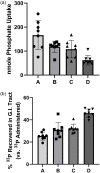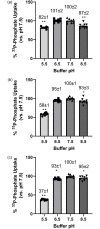Effect of an NHE3 inhibitor in combination with an NPT2b inhibitor on gastrointestinal phosphate absorption in Rodent models
- PMID: 38277356
- PMCID: PMC10817170
- DOI: 10.1371/journal.pone.0292091
Effect of an NHE3 inhibitor in combination with an NPT2b inhibitor on gastrointestinal phosphate absorption in Rodent models
Abstract
Many of the pathological consequences of chronic kidney disease can be attributed to an elevation in serum phosphate levels. Current therapies focused on decreasing intestinal phosphate absorption to treat hyperphosphatemia are inadequate. The most effective therapeutic strategy may be to target multiple absorptive pathways. In this study, the ability of a novel inhibitor of the intestinal sodium hydrogen exchanger 3 (NHE3), LY3304000, which inhibits paracellular, diffusional uptake of phosphate, to work in combination with an inhibitor of the active transporter, sodium dependent phosphate cotransporter 2b (NPT2b), LY3358966, was explored. LY3304000 modestly inhibited the acute uptake of phosphate into plasma of rats, while surprisingly, it doubled the rate of phosphate uptake in mice, an animal model dominated by NPT2b mediated acute phosphate uptake. In rats, LY3004000 and LY3358966 work in concert to inhibit acute phosphate uptake. On top of LY3358966, LY3304000 further decreased the acute uptake of phosphate into plasma. Studies measuring the recovery of radiolabeled phosphate in the intestine demonstrated LY3304000 and LY3358966 synergistically inhibited the absorption of phosphate in rats. We hypothesize the synergism is because the NHE3 inhibitor, LY3304000, has two opposing effects on intestinal phosphate absorption in rats, first it decreases diffusion mediated paracellular phosphate absorption, while second, it simultaneously increases phosphate absorption through the NPT2b pathway. NHE3 inhibition decreases proton export from enterocytes and raises the cell surface pH. In vitro, NPT2b mediated phosphate transport is increased at higher pHs. The increased NPT2b mediated transport induced by NHE3 inhibition is masked in rats which have relatively low levels of NPT2b mediated phosphate transport, by the more robust inhibition of diffusion mediated phosphate absorption. Thus, the inhibition of NPT2b mediated phosphate transport in rats in the presence of NHE3 inhibition has an effect that exceeds its effect in the absence of NHE3 inhibition, leading to the observed synergism on phosphate absorption between NPT2b and NHE3 inhibition.
Copyright: © 2024 Wang et al. This is an open access article distributed under the terms of the Creative Commons Attribution License, which permits unrestricted use, distribution, and reproduction in any medium, provided the original author and source are credited.
Conflict of interest statement
All authors are employees of Eli Lilly Co at the time of studied conducted. This does not alter our adherence to PLOS ONE policies on sharing data and materials.
Figures








Similar articles
-
Effects of pharmacological inhibition of the sodium-dependent phosphate cotransporter 2b (NPT2b) on intestinal phosphate absorption in mouse and rat models.Pharmacol Res Perspect. 2022 Apr;10(2):e00938. doi: 10.1002/prp2.938. Pharmacol Res Perspect. 2022. PMID: 35194979 Free PMC article.
-
Inhibition of sodium/hydrogen exchanger 3 in the gastrointestinal tract by tenapanor reduces paracellular phosphate permeability.Sci Transl Med. 2018 Aug 29;10(456):eaam6474. doi: 10.1126/scitranslmed.aam6474. Sci Transl Med. 2018. PMID: 30158152 Free PMC article. Clinical Trial.
-
Enhanced phosphate absorption in intestinal epithelial cell-specific NHE3 knockout mice.Acta Physiol (Oxf). 2022 Feb;234(2):e13756. doi: 10.1111/apha.13756. Epub 2022 Jan 11. Acta Physiol (Oxf). 2022. PMID: 34978760 Free PMC article.
-
Novel Treatments from Inhibition of the Intestinal Sodium-Hydrogen Exchanger 3.Int J Nephrol Renovasc Dis. 2021 Dec 1;14:411-420. doi: 10.2147/IJNRD.S334024. eCollection 2021. Int J Nephrol Renovasc Dis. 2021. PMID: 34880650 Free PMC article. Review.
-
Role of NPT2b in health and chronic kidney disease.Curr Opin Nephrol Hypertens. 2014 Jul;23(4):377-84. doi: 10.1097/01.mnh.0000447015.44099.5f. Curr Opin Nephrol Hypertens. 2014. PMID: 24848935 Review.
Cited by
-
New functions and roles of the Na+-H+-exchanger NHE3.Pflugers Arch. 2024 Apr;476(4):505-516. doi: 10.1007/s00424-024-02938-9. Epub 2024 Mar 7. Pflugers Arch. 2024. PMID: 38448727 Review.
References
MeSH terms
Substances
LinkOut - more resources
Full Text Sources
Medical

